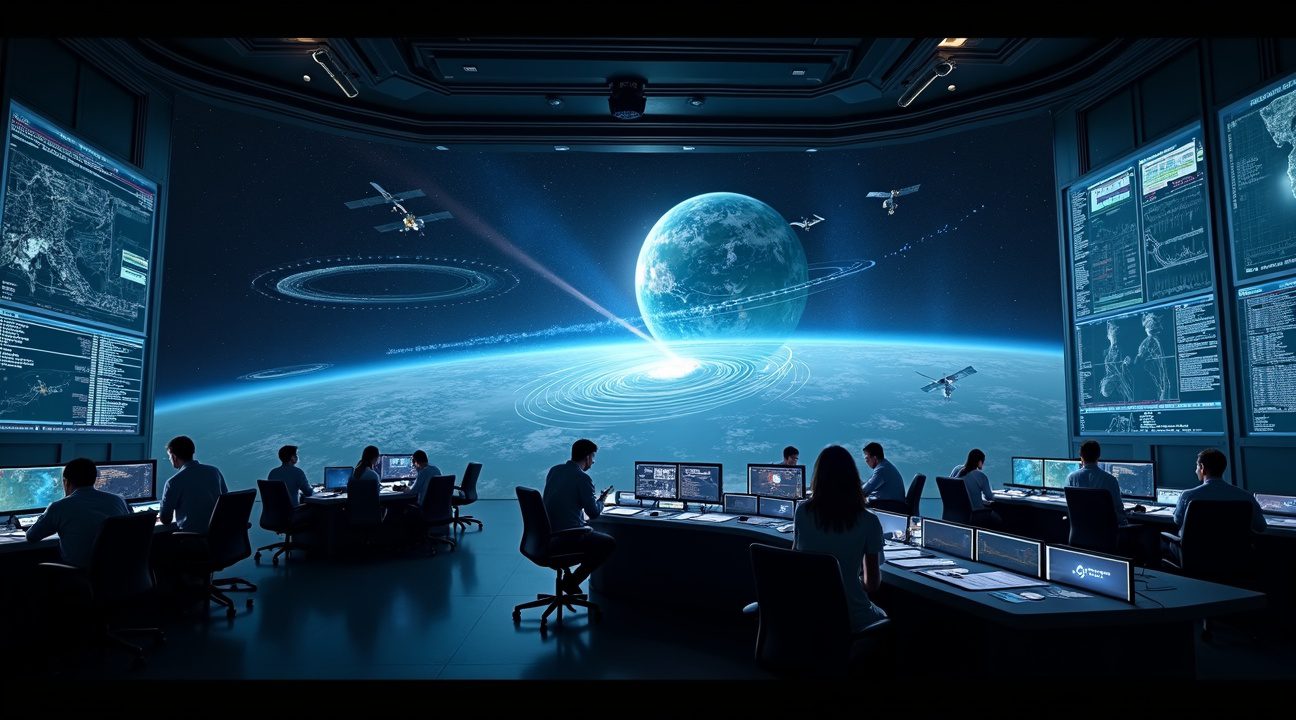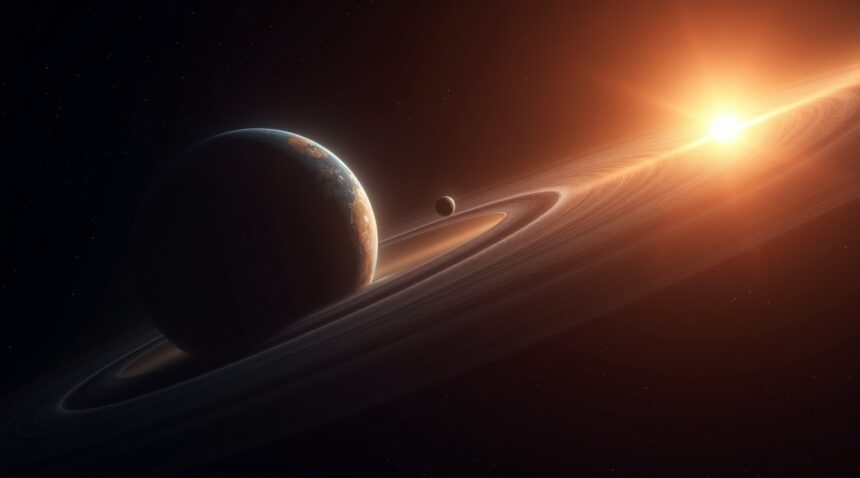NASA has officially confirmed the presence of a temporary second moon, identified as 2025 PN7, which is expected to persist in a quasi-satellite orbit around Earth until approximately the year 2083.
Key Takeaways
- 2025 PN7 is classified as a “quasi-moon” because it orbits the Sun independently. However, its trajectory is synchronized with Earth’s, causing it to appear as though it orbits Earth, despite not being gravitationally bound like a true moon.
- The asteroid will remain in Earth’s vicinity for nearly six decades—until around 2083. This ranks it among the longest-known quasi-moon relationships ever observed by scientists.
- With a diameter ranging from 18 to 36 meters and a visual magnitude of 26, 2025 PN7 is incredibly dim—about 100 million times dimmer than the faintest stars visible to the naked eye—and can only be observed using professional-grade telescopes.
- NASA has assured that 2025 PN7 poses no threat to Earth, maintaining a remarkably stable trajectory that ensures it won’t come close enough to impact our planet or its orbiting satellites.
- The discovery was made possible through advanced detection systems, such as PAN-STARRS, as well as various international collaborative efforts. These technologies underscore the evolving capabilities of modern astronomy in uncovering new celestial phenomena.
Earth Gains a Cosmic Companion: 2025 PN7 Will Follow Our Planet for Nearly Six Decades
I find it fascinating that Earth has acquired what scientists call a temporary second moon designated as 2025 PN7. This celestial object represents a remarkable astronomical phenomenon that will accompany our planet for decades to come. The discovery showcases how our cosmic neighborhood continues to surprise researchers with unexpected companions.
Understanding the Quasi-Moon Classification
2025 PN7 earns its classification as a quasi-moon due to its unique orbital characteristics around the Sun. Unlike our familiar Moon, which directly orbits Earth, this asteroid maintains a solar orbit that closely mirrors our planet’s path through space. This synchronized movement creates the illusion that 2025 PN7 follows Earth as a dedicated companion.
The asteroid’s orbital pattern differs significantly from traditional satellites. Instead of being gravitationally bound to Earth, it maintains its own independent trajectory around the Sun. This configuration allows it to appear as though it’s dancing around our planet while actually maintaining its separate solar orbit. Scientists find this orbital relationship particularly intriguing because it demonstrates the complex gravitational interactions that occur within our solar system.
A Six-Decade Journey Through Space
NASA confirms that 2025 PN7 will continue its companion-like behavior until approximately 2083, marking an unprecedented duration for such orbital arrangements. What makes this discovery even more remarkable is that astronomers believe this asteroid has likely maintained this quasi-moon status for at least the past sixty years. This extended timeline suggests that 2025 PN7 has been Earth’s silent companion far longer than previously recognized.
The longevity of this orbital relationship sets 2025 PN7 apart from other quasi-moons that scientists have identified. Previous discoveries of similar objects typically involved much shorter companion periods, sometimes lasting only months or a few years. The extended nature of this relationship provides researchers with valuable opportunities to study long-term orbital mechanics and gravitational influences.
Several factors contribute to the asteroid’s ability to maintain this stable quasi-moon orbit for such an extended period:
- The asteroid’s size and mass create optimal conditions for gravitational stability
- Its distance from Earth provides the perfect balance between solar and terrestrial gravitational influences
- The object’s velocity matches Earth’s orbital speed with remarkable precision
- Minimal interference from other planetary bodies allows for sustained orbital harmony
This discovery builds upon recent advances in space exploration and asteroid tracking capabilities. Similar to how SpaceX launches have expanded our reach into space, improved detection methods allow astronomers to identify and track these elusive cosmic companions with greater accuracy.
The identification of 2025 PN7 also connects to broader space research initiatives. Projects like lunar missions continue expanding our understanding of celestial mechanics, while discoveries of essential building blocks on other worlds remind us how interconnected our cosmic environment truly is.
Around 2083, 2025 PN7 will gradually drift away from its current Earth-companion orbit. This departure will mark the end of an extraordinary celestial partnership that spans nearly a century. The asteroid will continue its journey through the solar system, potentially establishing new orbital relationships or simply traveling as an independent space rock.
The study of 2025 PN7 offers scientists unprecedented opportunities to examine long-term asteroid behavior and orbital mechanics. This research contributes valuable data for understanding how small celestial bodies interact with larger planetary systems over extended periods. Such knowledge proves essential for future space missions and asteroid tracking programs designed to monitor potentially hazardous objects.
What Makes 2025 PN7 a “Quasi-Moon” Instead of a True Second Moon
2025 PN7 earns its classification as a “quasi-moon” because it doesn’t actually orbit Earth directly like our familiar lunar companion. This distinction becomes clear by examining how this space rock moves through our solar system.
This celestial object follows the Sun in its own independent orbit, just as Earth does. However, 2025 PN7’s trajectory runs remarkably similar to our planet’s path around the Sun. From Earth’s perspective, this creates an optical illusion where the object appears to be orbiting Earth, even though it maintains its own solar orbit.
The Dancing Partner Phenomenon
The quasi-moon’s movement creates a fascinating cosmic dance. As Earth travels around the Sun, 2025 PN7 loops around our planet while maintaining its solar trajectory. This dual motion allows it to stay relatively close to Earth for extended periods without becoming gravitationally bound like a true moon would be.
Professor Nicholson from Cornell University provides an excellent analogy for understanding this relationship. He compares a quasi-moon to “a wolf that follows a camp but never joins it—eventually leaving after decades.” This comparison captures the temporary and indirect nature of such cosmic companions perfectly.
Unlike our Moon, which remains locked in Earth’s gravitational embrace, 2025 PN7 will eventually drift away from our planet. The temporary capture aspect distinguishes quasi-moons from permanent satellites. While our Moon has orbited Earth for billions of years, this cosmic companion will break free from its current pattern and continue on its independent solar journey.
The key differences lie in gravitational relationships and orbital mechanics. True moons become gravitationally bound to their host planets, creating stable, long-term orbital relationships. Quasi-moons maintain their primary gravitational relationship with the Sun while appearing to dance around Earth due to similar orbital periods and paths.
This phenomenon isn’t entirely rare in our solar system. Scientists have identified several quasi-moons associated with Earth throughout history, though 2025 PN7 represents one of the longer-lasting examples. NASA’s ongoing research continues to track these temporary companions as they provide valuable insights into orbital dynamics and solar system mechanics.
The quasi-moon designation helps astronomers categorize objects that exhibit moon-like behavior without meeting the technical requirements for true satellite status. These cosmic companions offer unique opportunities to study gravitational interactions and orbital mechanics in real-time, contributing to our understanding of how celestial bodies move through space.
The Tiny Space Rock You’ll Never See Without a Telescope
I find it remarkable that Earth’s newest temporary companion, designated 2025 PN7, measures just 18 to 36 meters across—roughly the size of a small office building. This asteroid’s modest dimensions make it incredibly challenging to spot, even for experienced astronomers equipped with professional-grade equipment.
Why This Mini-Moon Remains Invisible to the Naked Eye
The asteroid’s visual magnitude of 26 places it far beyond human visual detection limits. To put this in perspective, the faintest stars visible without optical assistance have a magnitude of about 6.5 under perfect dark sky conditions. This means 2025 PN7 appears roughly 100 million times dimmer than the faintest naked-eye stars, making it accessible only through highly sensitive telescopes operated by research institutions.
Astronomers at the University of Hawaii made this discovery in 2025 through collaborative efforts with international observatories. Their success highlights how modern astronomical detection relies on sophisticated imaging systems rather than chance observations. The asteroid’s faint signature requires long exposure times and precise tracking to separate it from background stars and cosmic noise.
Advanced Detection Technologies Behind the Discovery
Sky surveys like PAN-STARRS have revolutionized how researchers identify these elusive objects. The Panoramic Survey Telescope and Rapid Response System continuously scans the heavens, capturing multiple images of the same sky regions to detect moving objects against the stellar backdrop. This systematic approach allows astronomers to spot asteroids that would otherwise slip past unnoticed.
The upcoming Legacy Survey of Space and Time (LSST) at the Rubin Observatory in Chile promises to enhance these capabilities dramatically. Once operational, this facility will photograph the entire visible sky every few nights, creating an unprecedented catalog of moving objects in our solar system. Such comprehensive monitoring systems will likely discover many more temporary moons and near-Earth asteroids in the coming years.
Detection methods for objects like 2025 PN7 involve several key techniques:
- Differential photometry compares brightness changes across multiple images
- Astrometric tracking measures precise positional changes over time
- Spectroscopic analysis determines surface composition and rotation rates
- Orbital modeling predicts future trajectories and capture scenarios
These tiny space visitors often escape detection until they’re already captured by Earth’s gravitational influence. The University of Hawaii’s discovery demonstrates how international cooperation strengthens our ability to monitor the space environment around our planet. Similar collaborative efforts have led to breakthroughs like discovering building blocks for life in distant locations.
Fast-moving objects present unique challenges because they appear to streak across star fields during long exposures. Advanced imaging software must distinguish between genuine asteroid detections and various forms of instrumental noise or cosmic ray hits. The asteroid’s small size and rapid motion create a double challenge—it’s both extremely faint and constantly changing position relative to background stars.
Professional observatories typically require multiple confirmation observations before declaring a new asteroid discovery. This verification process involves independent telescopes tracking the same object to confirm its orbital characteristics and rule out measurement errors. The precision required for such observations has improved dramatically with digital imaging systems and computer-controlled telescope mounts.
Space agencies now recognize that temporary moon captures occur more frequently than previously thought. Modern space exploration efforts benefit from understanding these natural phenomena, as they provide insights into orbital mechanics and potential future asteroid mining opportunities.
The discovery of 2025 PN7 represents just one example of how cutting-edge astronomical technology continues expanding our knowledge of Earth’s immediate cosmic neighborhood. These faint, fleeting companions offer valuable research opportunities despite their temporary nature and invisibility to casual stargazers.
Safety Assessment: No Threat to Earth Confirmed
NASA’s comprehensive evaluation of 2025 PN7 reveals no immediate or long-term danger to our planet. The space agency’s planetary defense teams have conducted thorough orbital analysis, confirming that this temporary moon maintains a stable trajectory that doesn’t intersect with Earth’s surface or critical infrastructure.
Continuous Monitoring and Tracking
I can confirm that multiple observatories worldwide are actively tracking 2025 PN7’s movement through sophisticated astronomical surveys. These monitoring systems employ advanced space technology to measure the asteroid’s position, velocity, and any potential orbital changes with remarkable precision. The tracking network includes both ground-based telescopes and space-based sensors that provide round-the-clock surveillance.
International partners collaborate with NASA to ensure comprehensive coverage of this celestial visitor. The data collected feeds directly into planetary defense protocols, which have been refined over decades of asteroid monitoring experience. Scientists analyze orbital mechanics continuously, looking for any deviations that might indicate a shift in trajectory.
Scientific Value Over Threat Assessment
Expert evaluations consistently classify 2025 PN7 as an object of scientific curiosity rather than concern. The asteroid’s extended stay in Earth’s gravitational influence offers researchers an unprecedented opportunity to study how temporary moons behave over multi-decade timeframes. This research could prove invaluable for understanding similar objects that might approach Earth in the future.
The asteroid’s size and composition make it particularly interesting for scientific study while simultaneously confirming its benign nature. Unlike larger potentially hazardous asteroids that require intensive monitoring, 2025 PN7 falls well below the threshold for objects that could cause significant damage even if its orbit were to change dramatically.
Current models predict the asteroid will maintain its quasi-satellite orbit until approximately 2083, after which it will likely escape Earth’s gravitational influence and resume its independent path around the Sun. This timeline provides ample opportunity for continued observation and research without any safety concerns for Earth’s population or infrastructure.
The success of massive slingshot project trials demonstrates NASA’s capabilities in tracking and potentially redirecting space objects when necessary, though such measures aren’t required for 2025 PN7.

A New Era of Solar System Discoveries Begins
The identification of 2025 PN7 demonstrates just how complex and dynamic our solar system truly operates. I find it remarkable that this asteroid reveals new layers of celestial mechanics that scientists continue to uncover even in Earth’s immediate neighborhood. This discovery represents far more than a single astronomical find—it signals the beginning of an era where our understanding of Earth’s companions will expand dramatically.
Advanced Detection Systems Transform Space Science
Cutting-edge observational technologies drive these groundbreaking discoveries. Programs like PAN-STARRS, the LSST, and the Rubin Observatory serve as the backbone for locating faint, small objects near Earth. These sophisticated systems can detect celestial bodies that previous generations of telescopes would have missed entirely.
I expect these initiatives to revolutionize how scientists catalog Earth’s dynamic companions. The detection capabilities now available allow researchers to spot objects that measure just tens of meters across while they drift through space at incredible distances. Such precision represents a quantum leap from the astronomical tools available even a decade ago.
These projects showcase remarkable global collaboration in space science. Research teams from multiple countries contribute data, analysis, and resources to create a comprehensive picture of our cosmic environment. The shared commitment to discovery emphasizes how curiosity and vigilance drive meaningful advances in our understanding of the solar system.
Earth’s Neighborhood Reveals Hidden Complexity
The existence of quasi-moons demonstrates that Earth’s vicinity contains numerous small, changing companions that orbit in intricate patterns. These objects follow paths that bring them close to our planet for extended periods before they eventually drift away into different orbital configurations. I find this celestial dance fascinating because it challenges traditional notions of what constitutes Earth’s immediate space environment.
Long-term quasi-moons like 2025 PN7 remain exceptionally rare discoveries. However, improved survey capabilities position scientists to detect many more of these objects in the coming years. The enhanced sensitivity of modern detection systems means that asteroids previously invisible to Earth-based observations now become trackable subjects for detailed study.
Future discoveries will likely reveal additional temporary moons, asteroid companions, and other small bodies that interact with Earth’s gravitational field. I anticipate that missions like SpaceX launches will provide even more sophisticated observation platforms for these investigations. The continuous improvement in space-based telescopes and ground-based arrays ensures that scientists can monitor increasingly smaller objects across greater distances.
Recent achievements in space exploration, including India’s moon mission and discoveries of life-building blocks on Saturn’s moon, demonstrate how rapidly our knowledge of the solar system expands. Each new finding builds upon previous research to create a more complete picture of celestial mechanics and planetary relationships.
The detection of 2025 PN7 also highlights how Earth exists within a much more populated cosmic environment than previously understood. Small asteroids, debris, and temporary companions constantly move through nearby space, creating a dynamic system that changes over time scales ranging from months to centuries.
Scientists expect that continued observations will reveal patterns in how these quasi-moons behave and interact with Earth’s gravity. This research could provide valuable insights for future space missions, asteroid mining operations, and planetary defense strategies. I believe the systematic study of Earth’s temporary companions will become an essential component of space science in the decades ahead.
The technological advances that enabled the discovery of 2025 PN7 represent just the beginning of what modern astronomy can achieve. Enhanced detection capabilities, improved data processing, and international cooperation continue to push the boundaries of what scientists can observe and understand about our solar system’s dynamic nature.
What This Discovery Means for Future Space Exploration
The identification of 2025 PN7 demonstrates how collaborative international efforts drive space science forward. Modern astronomical surveys have reached unprecedented levels of sophistication, enabling scientists to detect and track objects that would have remained invisible just decades ago. These technological improvements allow researchers to map our cosmic neighborhood with extraordinary precision.
Advancing Detection Capabilities
Current sky survey systems represent a massive leap in our ability to monitor near-Earth objects. Ground-based telescopes work alongside space-based observatories to create a comprehensive monitoring network that operates around the clock. Advanced imaging technology and automated detection algorithms process vast amounts of data, identifying potential objects within hours of their appearance in telescope feeds.
This enhanced detection capability has practical implications beyond academic curiosity. Scientists can now identify potentially hazardous asteroids earlier, giving Earth more time to prepare defensive measures if needed. The same technology that spotted our temporary companion also contributes to planetary defense initiatives that protect our planet from cosmic threats.
Future Implications for Space Science
The discovery of 2025 PN7 suggests that similar findings await in the coming years. As space exploration technology continues advancing, astronomers expect to uncover more temporary moons, previously unknown asteroids, and other celestial objects that pass through Earth’s gravitational influence.
These developments open new research opportunities that extend far beyond simple object detection. Scientists can study the composition and behavior of temporary moons to better understand asteroid formation and evolution. Such research provides valuable insights for future missions, including those focused on asteroid mining and planetary defense.
International cooperation plays a crucial role in these advancements. Data sharing between observatories worldwide creates a more complete picture of our solar system’s dynamics. This collaborative approach accelerates discovery timelines and ensures that no significant objects slip through detection networks.
The success of current monitoring systems also supports the development of more ambitious space exploration projects. As scientists gain confidence in their ability to track and predict object movements, they can plan more complex missions that take advantage of natural gravitational assists and temporary orbital mechanics. These capabilities directly support efforts to expand human presence beyond Earth, whether through commercial space ventures or government-sponsored exploration programs.
Modern astronomical surveys continue evolving, incorporating artificial intelligence and machine learning to process data more efficiently. These technological improvements promise even more dramatic discoveries in the years ahead, potentially revealing aspects of our cosmic environment that remain completely unknown today.

Sources:
ABC News – “Will Earth have 2 moons orbiting it? Astronomers explain the ‘quasi-moon'”
Republic World / YouTube – “Expert Talks About Why NASA Calls 2025 PN7 Earth’s Temporary Second Moon: Is It Dangerous?”
IOP Science – Original scientific publication on 2025 PN7 and quasi-moons (referenced by news sources)


